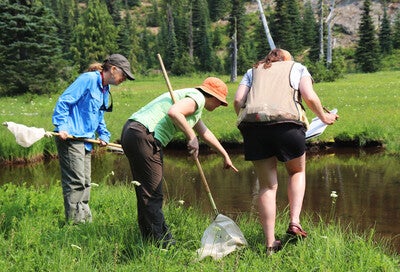When you hear the word 'scientist,' a particular image comes to mind: an individual donning a white lab coat surrounded by tubes, beakers, and Petri dishes. Perhaps someone with a background of years of schooling and lab hours. But what if I told you that you can be a scientist, regardless of education, location, and attire?

If that sounds appealing, then you'll be participating in a movement known as citizen science. Citizen science is scientific research conducted with the public's help, collaborating with or under the direction of scientists or scientific institutions. These projects often require datasets that are too large for scientists to be able to capture themselves, and that's where the public proves helpful. Anyone with a smartphone or computer, whether out on a walk or sitting at home, can participate. And even better, you can help federally supported projects from top government agencies like NASA, National Park Service and Forest Service, amongst many others!
Here are some notable examples of active projects:
Are we alone in the universe?
Have you ever looked into the night sky and wondered if we were alone in this vast universe? With Are we alone in the universe, you can help NASA answer that question. The project uses the largest steerable telescope on Earth to discover life outside of our planet, observing radio frequencies emitted from stars and their planetary systems. Citizen Scientists help classify these sounds compared to already logged known frequencies to create an artificial intelligence (AI) that could help speed up the process.
SandSnap
If you find yourself vacationing on a beautiful beach and have some spare change, you can help science. How's that? By taking a picture and sharing it with SandSnap! A simple cell phone picture of the sand compared to a coin can help the Department of Defense make better management decisions in the future by grasping the complex nature of an ever-changing environment. The grain size of beach sand is essential in understanding coastal dynamics and studying them properly. There is no database on sand grain size, and the U.S. Army Corps of Engineers is looking for help creating one.
Nature's Notebook
Helping one organization is great, but what about assisting numerous groups simultaneously? With Nature's Notebook, you're working with the National Park Service, National Oceanic and Atmospheric Administration, NASA and the National Science Foundation, amongst others. Like SandSnap, this project works for those who find themselves outside but would like to add more to their walk or hike. You can gather data on your local plant and animal phenology or the cyclical study of the relationship between life and climate, like the timing of nectar sources for butterflies or recording dates that leaves change color in autumn. Guides are provided to help citizen scientists get started, along with localized lists of plants and animals you can observe. Campaigns are also available that you can join to support specific areas of interest left to research, like Desert Refuge, a collaboration with our own Desert Botanical Garden.
Partnering with U.S. government-sponsored projects is not the only way to put on your scientist cap and get involved. There are other gateways like SciStarter and Zooniverse, to name a few.
Making an impact in science is now something that is no longer just reserved for those who specialize in the field. It's a growing community that needs all the help it can get from those who have a particular passion and are willing to lend a hand. There are ways to get involved no matter where you are, what you're doing and what kind of technology you have. Through science, we better understand the world around us, and with the growing challenges that the world faces, who better to contribute to change than its citizens?
Other resources:
- Society for Science - Research at Home: Citizen Science
- CitizenScience.org
- ASU Citizen Science LibGuide
- The Field Guide to Citizen Science, by Darlene Cavalier, Catherine Hoffman, and Caren Cooper, which you can check out from our library. While there, check out the rest of the new Open Science featured collection on the 3rd Floor of Hayden Library!
